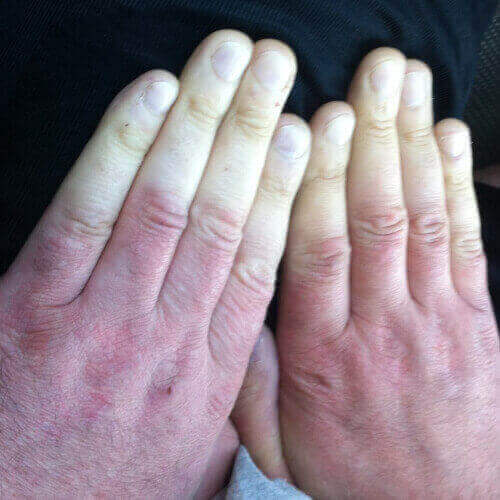Signs of Hand-Arm Vibration Syndrome
From Dr. Z - Carpal tunnel syndrome specialist
What is Hand Arm Vibration Syndrome?
Do you work with vibrating equipment? If so, act fast to identify and prevent hand-arm vibration syndrome (also called HAVS or "vibration syndrome"). If you don't stop it early, it becomes permanent: you cannot reverse or cure it.
Most people get hand-arm vibration syndrome from exposure to vibrating tools on the job. The symptoms mainly include finger and hand
numbness or tingling. There are other symptoms and signs. Here is what you need to look out for.
- FIND OUT: do you have carpal tunnel?
No strings attached self-test.
Where does hand arm vibration syndrome come from?
Many people who use vibrating power tools like jackhammers, power saws, and drills know this condition. Hand arm vibration syndrome is actually an occupational injury due to exposure to these vibrating tools. Generally, such tools produce medium frequency, high amplitude vibrations.
Note that hand arm vibration syndrome is not the same as carpal tunnel syndrome. The latter is a problem with the tendons inside the wrist joint. The only similarities are some of the symptoms, like hand and finger tingling and exposure to high-risk jobs causing both conditions.
Types of vibration syndrome
This condition actually has three separate components. All three are related, but you don’t need all three to have hand arm vibration syndrome.
- Nerve injury (or peripheral neuropathy): Vibration injury in the hand causes numbness or tingling in the fingers and hand. You may have some loss of hand function (dexterity).
- Reynaud’s syndrome: This is sometimes called “vibration white-finger” because fingertips turn white or discolor. As the condition advances, the discoloration also advanced down the fingers to the hand. Fingers may also feel tingly.
- Musculoskeletal problems: This category include weakness, discomfort, and pain. The feelings can occur anywhere from the fingers to the elbow.
Early signs
The early signs and symptoms of hand arm vibration syndrome start slowly and almost go unnoticed. Usually, symptoms start in the fingers and hand.
Spot these HAVS symptoms before it's too late:
- tingling (usually most noticeable after using vibrating equipment or at night)
- prickling or pins-and-needles
- numbness (accompanied with loss of sensation, and may come and go, particularly at night)
- loss of strength and dexterity (you may drop things, or fumble trying to pick them up)
- white finger (at the tips of your fingers, mostly during wet or cold conditions, and are painful upon recovery)
Advanced signs
If you have not taken action with the Early Signs, then HAVS will worsen -- particularly if you continue using vibrating tools.
As hand arm vibration syndrome worsens, symptoms include episodes of pain in the fingers that can last several minutes. Usually, during these episodes one or more fingers can discolor or turn white (blanching). Generally, such episodic attacks increase in length and frequency with continued exposure to vibration, cold temperatures, and smoking. They go from episodic to permanent.
More advanced hand-arm vibration syndrome will result in:
- severe pain (you might wake up while trying to sleep)
- more severe numbness
- continued loss of strength and dexterity
- more extensive white finger that doesn't recover
What you can do
Unlike carpal tunnel syndrome and tendonitis, vibration syndrome is not reversible. There is no cure and its treatment is very difficult. However, if caught in the early stage, you can reduce the Raynaud’s phenomenon symptoms. You can also stop the progression of HAVS. But there’s no reversing the neurological injury (neuropathy) that's already occurred.
The best hope for patients with vibration syndrome is that it does not progress. Generally, pain management is the only course of action. For those at high risk of developing hand arm vibration syndrome, the key to not suffering is prevention.
The National Institute for Occupational Safety and Health (NIOSH) collects data on hand arm vibration syndrome. They say that for those already who use power tools professionally, the workplace prevalence of vibration syndrome is between 20% and 50% in the USA. That means every day, 2.5 million Americans expose themselves to the likelihood of developing this condition just from power tools.
And since there is no treatment for hand arm vibration syndrome, much of the attention has been on vigilance and prevention.
NIOSH's recommendations
The best way to limit vibration exposure is to limit vibration duration and reduce vibration levels. These goals can be achieved by:
- Engineering changes: This means modifying tools used on production lines. NIOSH also recommends the redesign of tools to minimize vibration on workers’ hands.
- Medical surveillance and worker education: The key here is informing the worker of the dangers and signs of hand arm vibration syndrome. Also, worker education should include
avoidance practices as well as ways to get medical attention early on.
- Work practices: Much of these recommendations fall on the employer. The employer should maintain vibrating tools to the manufacturer’s standard. Also, vibrating tool users should have
10 minute breaks per hour when using the tools. Job rotation is also recommended.
- Personal protective equipment (PPE): These recommendations focus on reducing vibration from the tool to the hands. Good quality, insulated
gloves are a huge positive measure. However, gloves alone are not the only way to reduce vibration. Use the proper tool for the job. Choose equipment with lower vibration. Maintain tool condition and sharpness.
Summary
Symptoms of hand arm vibration syndrome (HAVS) can be similar to carpal tunnel syndrome. But the two conditions are very different. You can't cure HAVS. But you can prevent it from ever happening if you pay attention to your workplace and the vibrating tools you use.



